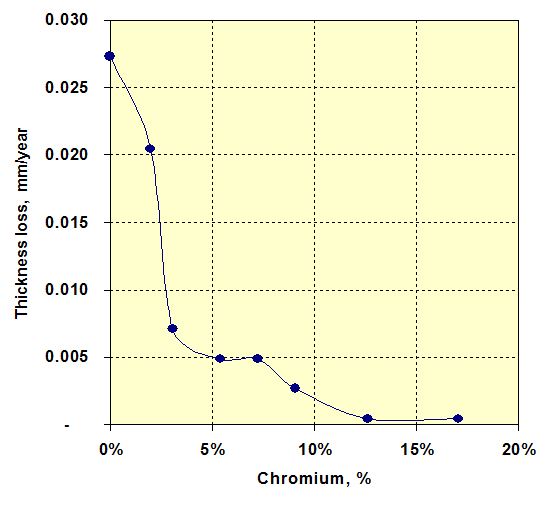Stainless Steel Grade 430
 |
Product Data Sheet – Stainless Steel |
Grades 430 UNS-S43000 |
Stainless Steel Grade 430 is the most commonly used ferritic stainless steel. It is moderately corrosion resistant, and is useful in mildly corrosive conditions. Grade 430 has useful resistance to heat and oxidation, and is not susceptible to stress corrosion cracking. Typical ApplicationsWhitegoods (dishwashers, washing machines, dryers), benches, cabinets, automotive trim, interior architectural components. Chemical Composition(AS1449 / ASTM A240 – Flat Products)
Mechanical Properties(AS1449 / ASTM A240 – Flat Products)
DescriptionGrade 430 is ferritic chromium steel, with useful corrosion resistance. It has good formability and fabrication characteristics, although inferior to the austenitic stainless steels. In most applications the steel is used where the corrosion environment is only mildly aggressive, when it gives long lasting appearance and service life. AvailabilityAustral Wright Metals can supply this grade as plate, coil, sheet, strip, round, hexagon, flat bar, tube, pipe and fittings, forging billet and forgings. It is stocked as sheet and coil, other product shapes can be supplied to order. FinishesBA (bright annealed), N4 (polished), 2B (cold rolled, skin passed). Most 430 is used in the BA of N4 finishes. Flat products are available surface protected with white polyethylene (PE) film. Corrosion ResistanceGrade 430 gives useful corrosion performance in mild environments. Austral Wright Metals will be pleased to provide advice for specific applications. Grade 430 is resistant to stress corrosion cracking, and may be used where grade 304 might fail in this mode. It will resist tarnishing in indoor applications. It is also used in whitegoods, where it resists corrosion by potable water, with a short time-of-wetness. It is not suitable for immersion applications in water. The Influence of Chromium Contenton atmospheric corrosion of iron chromium alloys
Similar curves apply for many different corrosion situations. Grade 430 has slightly lower chromium content than austenitic grade 304, giving inferior corrosion resistance. Physical Properties(Typical, annealed)
ToughnessGrade 430 stainless steel fractures in a ductile manner at room temperature. However, it is difficult to weld without loss of toughness and is not used in structural applications. Pressure VesselsAS1210, Pressure Vessels, allows the use of grade 430 up to a temperature of 650°C, as plate, seamless pipe and tube, and bar. 475ºC EmbrittlementWhen ferritic stainless steels are heated to temperatures above about 340°C, toughness is reduced and the material becomes brittle. The maximum effect occurs at about 475°C. The toughness can be restored by heating to temperatures above 515°C and rapidly cooling. Sigma Phase FormationPrecipitation of sigma phase can occur after long exposure in the 450 – 810°C temperature range, with loss of toughness and corrosion resistance. SensitisationAs with the austenitic grades, 430 may suffer sensitisation and loss of corrosion resistance due to precipitation of carbides. This occurs when heated above about 880°C. Annealing sensitised 430 at 800°C will eliminate sensitisation. Even heats of 430 with carbon content below 0.03% can sensitise, and there is no 430L low carbon analogue to 304L. It is possible to obtain a stabilised version, 430Ti, which uses a titanium addition to eliminate sensitisation. High Temperature CorrosionThe generally accepted maximum service temperatures for grade 430 in air are 870°C for intermittent service and 815°C for continuous service. Cold FabricationGrade 430 is readily workable, by the standard methods of sheet metal working, with the exception that it cannot be oxygen cut. Plasma cutting is normal. The deep drawability of grade 430 is good. The grade behaves in a similar way to carbon steel during fabrication. ForgingGrade 430 is one of the easier austenitic stainless steels to forge, at temperatures 850 – 1120°C, finishing at any temperature down to about 705°C. 430 should be annealed after forging. MachinabilityGrade 430 is slightly easier than the austenitic grade 304 to machine, although more difficult than carbon steel. More power is required to machine grade 430 than carbon steel. Cutting speed should be lower, the feed higher, tooling and equipment heavier. The machinability of 430 is about 60% that of AISI B1112 resulphurised free cutting carbon steel. Heat TreatmentSolution annealing is performed at 1065 – 1120°C, followed by rapid cooling to prevent the precipitation of the chromium carbides. 430 cannot be hardened by heat treatment. WeldabilityIt is difficult to make a sound structural weld in grade 430 by fusion techniques. The limited phase change at higher temperatures gives coarse ferrite grains with grain boundary martensite films in the HAZ. Precipitation of carbides during cooling also leads to sensitisation. Welds are both brittle and have lowered corrosion resistance. Post weld heat treatment is able to achieve tough, corrosion resistant welds, but the cost may outweigh the cost of using an austenitic grade. The grade is not used for structures. Grade 430 can be joined by spot, seam, and induction welding. Grade 430Ti gives better toughness and corrosion resistance in the welded zone. However, the surface appearance of 430Ti is inferior to 430 due to the presence of particles containing titanium, which intersect the surface. Grade 309 filler metal is normally used for fusion welding. It is pre-qualified in AS1554.6:1994 for welding grade 430 to itself, carbon steels and most stainless steels except the duplex grades. Similar curves apply for many different corrosion situations. Grade 430 has slightly lower chromium content than austenitic grade 304, giving inferior corrosion resistance. | ||||||||||||||||||||||||||||||||||||||||||||||||||||||||||||||||||||||||||||||||||||||||||||||||||||||||||||

